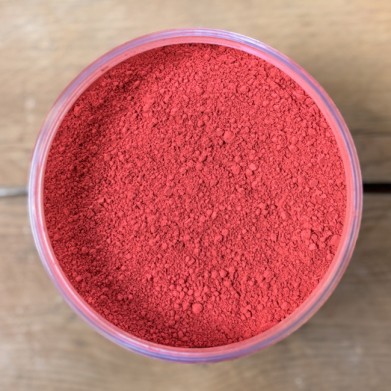




Rouge cinabre is a pigment preparation created by Ocres de France in 2019.
This pigment is synthetic, without any danger for health or the environment.
![]()
Pigment made by Ocres de France
![]()

Legal notices

Delivery policy

Return policy

Google reviews
Uses : lime paint, lime coating, wax, paint, plaster, fresco, glaze, cement, fine arts.
This pigment is in powder. For use in artistic painting, it should be ground finely in a mortar before mixing it with the binder.

Rouge cinabre mixed with linseed oil
Linseed oil : dissolve the powder in a little bit of turpentine before adding it to the linseed oil.
Water-based paint/fatty lime : dilute the pigment in some water to make it liquid before incorporating it into the paint.
Lime powder/cement/plaster : directly incorporate the pigment (up to 10% based on the weight of the binder), then mix in order to stain all of your binder.
Maximum dosage : The maximum dosage is 10% compared to the binder used. Above 10% it is recommended to incorporate fixators and adjuvant (lime use).
Results of Rouge cinabre mixtures according to our packaging, in our limewash Badisof naturel
These renderings can be similar for any white base mixed with this pigment. However, differences could be possible depending on the binder used, the support and/or the application technique used, which will give a final color more or less light. The mixing possibilities are endless, while respecting the maximum dosage.
If you want to lighten a pigment, before coloring a transparent binder (linseed oil, wax, acryling binder, caparol, flour, etc), you can mix it with blanc Tiona (= white Tiona).
Color : red vermillon with a transparent binder. Fresh bright pink with a white binder.
This pigment is 100% synthetic without any danger for health or for the environment.
Made in France.
History : at the beginning, it was in China that cinnabar - red mercury sulphide - was used. Then, traces of it are found in Asia Minor and in Greece. The Romans imported it in Spain. It was a very expensive pigment. As a result, it is also one of the first pigments to be manufactured artificially from the 8th century. Nowadays, synthetic cinnabar is no longer compounded with mercury sulphide. Pigment created in 2019 by Ocres de France.
_____________________
Our packaging :
We use recyclable PET jars, to throw away, cleaned, in the yellow bins ; and glass jar that you can clean and sterilize for other uses even for food storage.